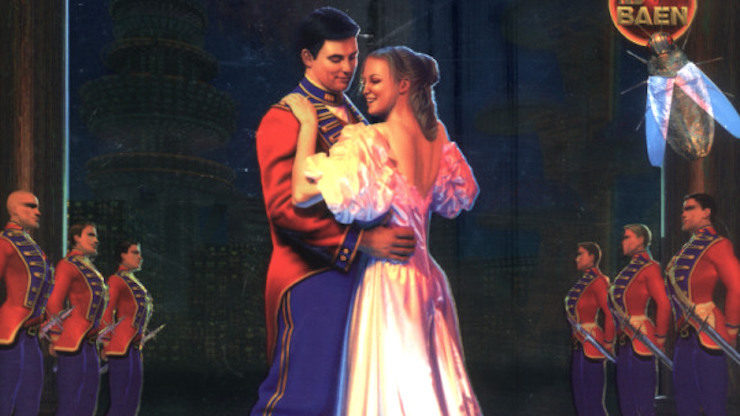A Civil Campaign was first published in 1999. In the great epic that is the Vorkosigan Saga, this is a “coming home” section. It has a number of science fictional elements—more than one planet, space travel, butter bugs—but the central narrative is the love story between Ekaterin and Miles. This is the most romantic of the books since Shards of Honor, which was comparatively very grim. This puts book publishers in a bit of a bind. A cover needs to sell the book—do they play up the SF and make sure the SF fans pick it up, or do they emphasize the romance and grab some new readers? What if readers think the book has girl cooties?
Some of the translated editions chose to err on the side of SF. Some of these errors were smidge egregious for my taste.
The Italian edition features a group of people carrying swords in front of a vaguely-futuristic city. The title translates as “War Strategies.”
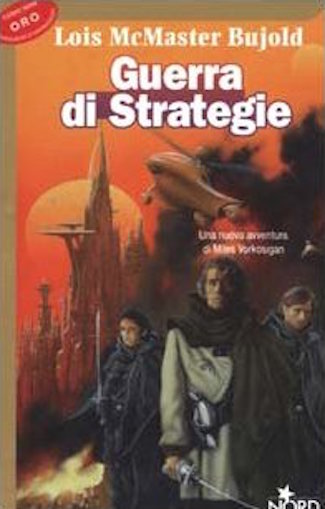
The Chinese cover features a gorgeous painting of a spaceship by John Berkey. Google informs me that the title translates as Infighting.
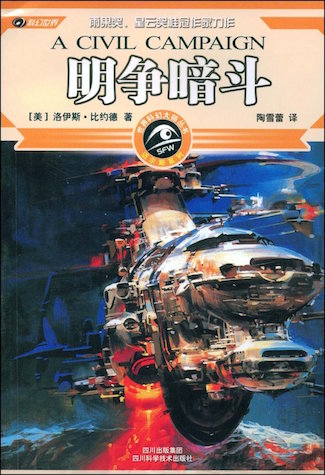
The German edition is perhaps excessively subtle, but at least hints that this is not hard military SF. My German is terrible, so I initially thought the title might mean The Bugmaker, but Google Translate informs me that it is The Ambassador.

The Kindle edition features this adorable butter bug, armed with a pair of crossed roses. As a rule, I don’t like bugs, but if I lived in Vorkosigan’s district, I would keep this little guy as a pet. This is the most romantic possible bug. That said, it is a bug. Your average romance reader doesn’t see a lot of book covers featuring bugs, even in the shape-shifter genre that’s become so popular in the last few years.
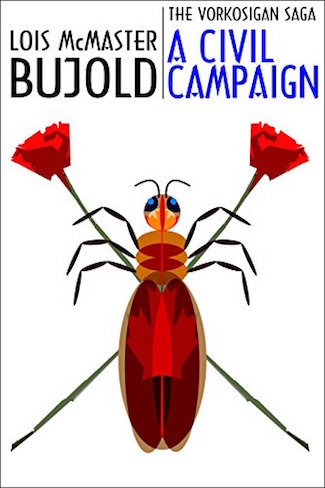
This resistance to romantic themes recalls the “no girls here!” approach showcased on many editions of Ethan of Athos, but the art on most editions was more open to addressing the book’s subject matter.
Baen’s first edition cover is just one that emphasized the romance. I like the composition here. Gregor and Laisa are centered, dancing, surrounded by guards, with a smattering of butter bugs around the edges. I hate the execution. Gregor’s uniform fits horribly—like his parents bought it a size big to leave room to grow. The man is 35, and he has an excellent tailor. Laisa’s dress doesn’t match the description in the book. How did she ride a horse in that? Where is her bolero? Laisa doesn’t match the description in the books either—Her hair should be darker and she’s supposed to be a little plump. And Gregor and Laisa look like they’re slow dancing at the seventh grade social. This is not a good reflection of the ballroom dance skill I associate with the High Vor. The guards appear to have been computer generated, and I’m concerned that they’re all going to end the day with lower back spasms. The bugs came out OK. A number of other artists handled the romantic subject matter more gracefully.
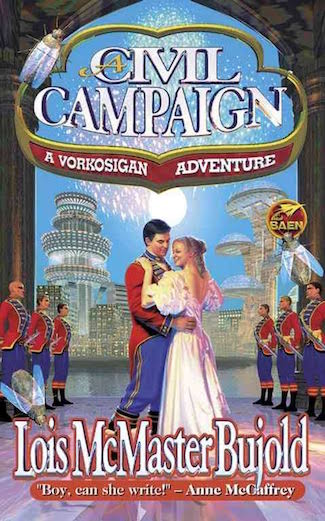
In a major departure from his usual muscle-bound, almost masochistic approach, Esad Ribic depicted Miles with flowers and handful of flimsies. The location doesn’t mesh with the scene, and I hadn’t thought of bare arms as being usual for urban Vor making afternoon calls, but it’s true to the emotional moment.
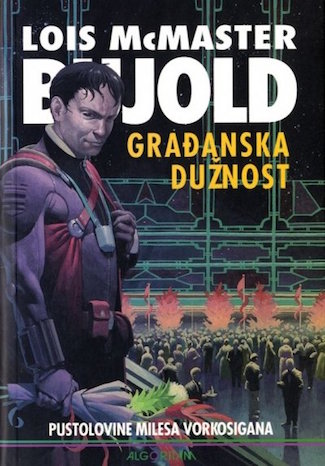
The Japanese covers are gorgeous. Ekaterin appears to be visiting Vorkosigan Surleau. Barrayaran lightflyers often look like bugs to me—this one looks like a ladybug. Miles is shown with his groundcar, which is, as Nikki will note, a barge.
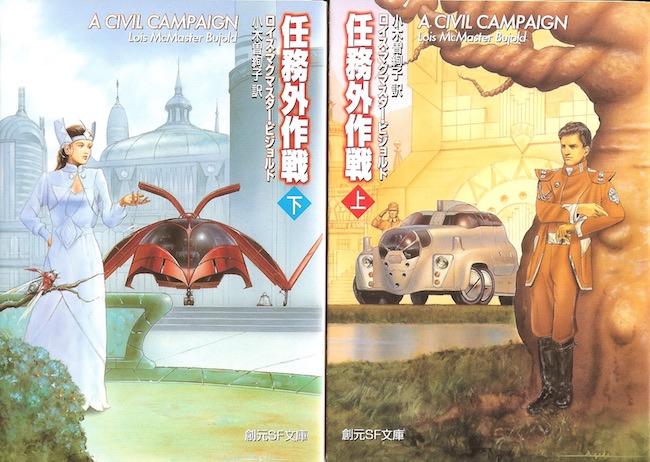
The French cover features Ekaterin and Nikki, him looking understandably sulky, her looking elegant and composed. The bug in the foreground looks like it could plausibly consume radioactive waste.
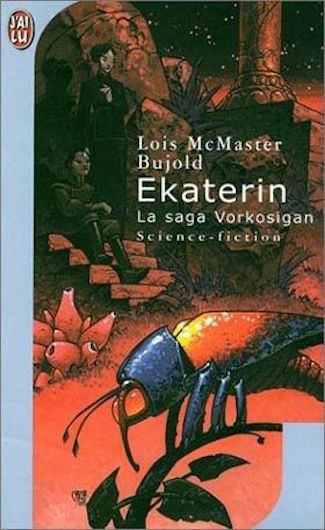
The Czech cover puts some weird structures (traffic control?) and flying cars in the background for science fictional verisimilitude, with Miles and his groundcar in the foreground. The quantity of roses here suggests both Miles’s depth of feeling and his difficulty expressing himself.
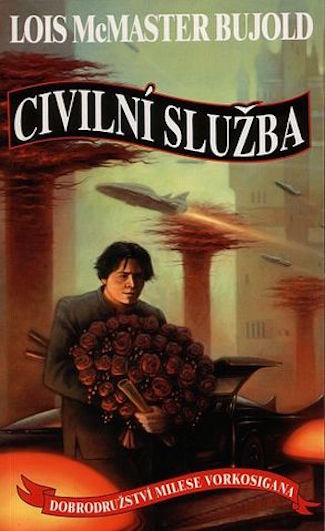
I am delighted by so much of A Civil Campaign that I have a hard time being dignified about it. Bujold plunges right in to the romantic arc she left unfinished in Komarr. Miles has a lot of flowers and a cunning plan. He invites Ekaterin to visit Vorkosigan House with an eye to taking on the job of being his landscape designer for an otherwise useless vacant parcel that abuts the house. I think it’s telling that he approaches Ekaterin with a map of his empty lot. It’s a symbol of his tendency towards military thinking. He has an objective and he needs a map. Miles also has an enemy—he thinks. Ivan encounters Ekaterin when he comes to Vorkosigan House with wedding planning chores from Lady Alys.
Ivan doesn’t complain to Miles about his recent romantic difficulties, but he’s been struggling. He’s handsome, he’s charming, and the ladies of Vorbarr Sultana are just as willing to use him as the ladies of Cetaganda were, although not in the same way. Plus, he’s past thirty, which is around the time a person’s boyish charm starts to fade. Ivan isn’t competition for Ekaterin’s affections, but this is our first look at Miles’s reaction to perceived competition. Miles really likes to control everything. He does not control Ivan, he does not control the Vorbarr Sultana social scene, and he does not control Ekaterin. His life is about to become very complicated.
Ellen Cheeseman-Meyer teaches history and reads a lot.










